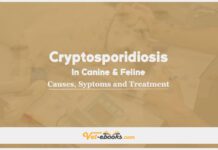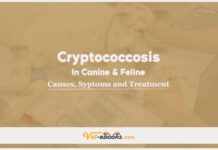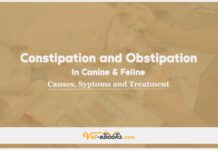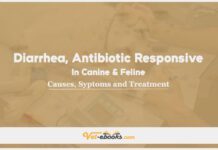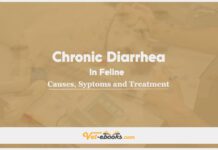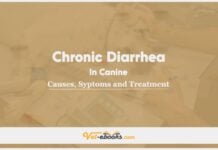Colibacillosis In Canine and Feline: Causes, Symptoms and Treatment
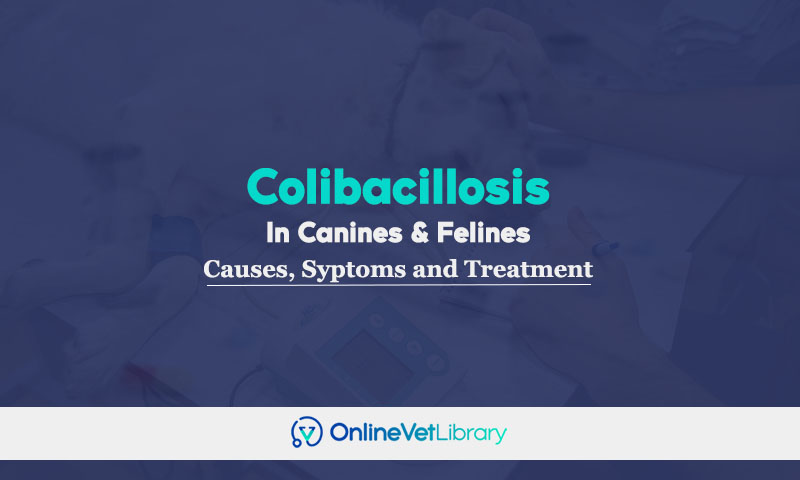
Overview
Bacterial infections caused by Escherichia coli (EC), which is a Gram-negative member of the Enterobacteriaceae family, are common. In the case of puppies and kittens, acute infections can occur during their first week of life, often manifesting as septicemia and involving multiple organs. The presence of EC in the stool of young animals is inconclusive evidence of its pathogenic potential cause it is considered a normal part of the flora so More convincing evidence of EC causing infection is its isolation from blood cultures or internal organs.
Causes of Colibacillosis In Canine and Feline
Causes:
- E.Coli: microbial flora of the GI tract, prepuce, and
vagina. - many strains difficult To determine its virulence potential, molecular methods are needed
- Often found in older dogs and cats
It is frequently discovered in older dogs and cats, often in conjunction with other infectious agents.
Risk factors
- Lack of colostrum or insufficient colostrum for the neonates.
- Bitch/queen in poor health and nutritional status.
- Crowded facilities with feces in the environment, increase the risk of fecal-oral transmission.
- Difficult or prolonged labor and birth.
- concurrent diseases like parvovirus or severe parasitism.
- Use of antimicrobial drugs, which can disrupt the gastrointestinal microbial flora.
- Individuals with weakened immune systems.
- Occurrence of postparturient mastitis.
Pathogenesis of Colibacillosis In Canine and Feline
- Virulence Factors:
- Virulence factors of Escherichia coli (EC) are not well defined.
- The likelihood of EC causing septicemia in neonatal dogs and cats seems to be related to the balance between the immaturity of the immune system and the intestinal barrier function of the host, along with the presence of resident enteric EC strains, rather than being attributed to a single highly virulent strain.
- Types of E.Coli Strains:
- Enterotoxigenic EC (ETEC), attaching and effacing EC (AEEC), uropathogenic EC (UPEC), and cytotoxic necrotizing factor (CNF) positive EC strains have been recovered from dogs and are similar in cats.
- Intestinal strains of EC typically colonize and multiply in the small intestine. ETEC strains elaborate uncharacterized adhesins and enterotoxins.
- Many EC strains from dogs and cats are hemolytic.
- Unique E.Coli Variant in Boxer Dogs with Granulomatous Colitis:
- A specific variant of EC has been identified in Boxer dogs with granulomatous colitis.
- This variant has the ability to adhere to, invade, and replicate within macrophages, leading to a substantial inflammatory response within the intestinal wall.
Symptoms (History & Physical Examination) of Colibacillosis In Canine and Feline
History:
- Neonates:
- Abrupt vomiting
- Signs of weakness or lethargy
- Diarrhea
- Cold Skin
- Symptoms can affect one or more animals within the same litter
- Puppies, Kittens, and Adult Animals:
- Common symptoms include vomiting and diarrhea
- Older Dogs and Cats:
- Primarily experience diarrhea
- May also suffer from various health issues such as:
- Urogenital problems (cystitis, endometritis, pyelonephritis, prostatitis)
- Ear infections (otitis)
- Pneumonia
- Liver and gallbladder disorders (hepatobiliary disease)
- Endocarditis
- Rarely, inflammation of the brain and spinal cord (meningoencephalomyelitis)
- Boxer Dogs:
- Higher predisposition to large-bowel colitis
Physical Examination
Neonates:
- Acute depression
- Anorexia
- Vomiting
- Tachycardia
- Weakness
- Hypothermia
- Cyanosis
- Watery diarrhea
Puppies, Kittens, and Adults:
ETEC (Enterotoxigenic Escherichia coli) associated symptoms:
- Acute vomiting
- Diarrhea
- Anorexia
- Rapid dehydration
- Fever
Diagnosis of Colibacillosis In Canine and Feline
1- From History and Physical Examination
2- Diagnostic Procedures
- CBC/BIOCHEMISTRY/URINALYSIS:
- Few abnormalities are observed due to the swift progression of death in puppies
- Adults with Enteritis Nonspecific abnormalities may be present, depending on the specific condition.
- Diagnosis:
- For diagnosis, it is essential to conduct routine bacterial culture and identify Escherichia coli (EC) from either antemortem blood samples or various post-mortem tissue sources, including bone marrow, heart blood, liver, spleen, brain, and mesenteric lymph nodes.
3- Differential Diagnosis:
Infectious Enteritis:
- Viral Infections:
-
-
- Feline panleukopenia
- Feline leukemia virus
- Feline immunodeficiency virus
- Enteric coronavirus
- Canine parvovirus
- Rotavirus
- Canine distemper
-
- Bacterial Infections:
-
-
- Salmonella
- E. coli
- Campylobacter jejuni
- Yersinia enterocolitica
- Bacterial overgrowth syndrome
- Clostridium difficile
- Clostridium perfringens
-
- Parasitic Infections:
-
-
- Hookworms
- Ascarids
- Whipworms
- Strongyloides
- Giardia
- Coccidia
- Cryptosporidia
- Rickettsiae (e.g., salmon poisoning)
-
- Dietary-Induced Enteritis:
-
- Overeating
- Abrupt dietary changes
- Starvation
- Food intolerance or allergy
- Dietary indiscretions (e.g., ingestion of foreign material or garbage)
- Drug- or Toxin-Induced Enteritis:
- Antimicrobial agents
- Antineoplastic agents
- Anthelmintics
- Exposure to heavy metals
- Organophosphates
- Extraintestinal Disorders or Metabolic Diseases:
- Acute pancreatitis
- Hypoadrenocorticism
- Liver or kidney disease
- Pyometra
- Peritonitis
- Functional or Mechanical Ileus:
- Gastrointestinal obstruction
- Intussusception (telescoping of the intestine)
- Electrolyte disorders
- Gastrointestinal foreign bodies
- Neurologic Disorders:
- Vestibular disease
- Psychogenic factors (e.g., fear, excitement, pain)
- Fading Neonates: A condition observed in neonatal animals with unexplained failure to thrive.
Treatment of Colibacillosis In Canine and Feline
General :
- Management of Acutely Ill Neonates:
- Ensure they are placed in a heated environment to maintain body temperature.
- Fluid Administration:
- Administer parenteral fluids containing glucose.
- Nutrition for Neonates:
- When neonates become stronger and capable of oral intake, consider tube feeding with a balanced milk substitute.
- Overall Care Focus:
- Pay close attention to maintaining warmth, facilitating elimination, and ensuring proper hydration.
Medications:
- Antimicrobial Therapy for Septicemia:
- Treatment guided by culture and susceptibility testing of Escherichia coli (EC).
- Empiric therapy is recommended until test results are available.
- Note that extended-spectrum β-lactamase (ESBL) and/or plasmid-mediated AmpC (pAmpC) strains are becoming more common.
- Recommended Antibiotics and Dosages:
- Amikacin (for dogs and cats):
- Dosage: 15–20 mg/kg IV every 24 hours.
- Cefazolin (for dogs and cats):
- Dosage: 15–35 mg/kg IV every 6–8 hours.
- Cefoxitin (for dogs and cats):
- Dosage: 30 mg/kg IV initially, followed by 15 mg/kg IV every 6–8 hours.
- Enrofloxacin (for dogs and cats):
- Dog Dosage: 10–15 mg/kg IM/IV every 24 hours.
- Cat Dosage: 5 mg/kg IV every 24 hours.
- Ticarcillin–Clavulanate (for dogs and cats):
- Dosage: 50 mg/kg IV every 6 hours.
- Amikacin (for dogs and cats):
Some Notes:
- Limited knowledge on the potential of EC strains from dogs or cats to harm humans.
- Recent discoveries indicate similarities between canine fecal bacteria (UPEC) and human EC, which is associated with urinary tract infections, sepsis, and meningitis.
- Growing concern regarding the presence of drug-resistant strains of EC in companion animals.
- It is advisable to keep children and immunosuppressed individuals away from pets with diarrhea.
- Whole genome sequencing has established a connection between commercially available raw meat diets and the presence of pathogens such as EC, Salmonella, and Listeria in dogs and cats.
Do You Want To Increase Your Veterinary Knowledge and Practical Skills?
You Can Now Browse and Download +3000 Books For Veterinary Professionals & Students Online.
Download Veterinary Books

